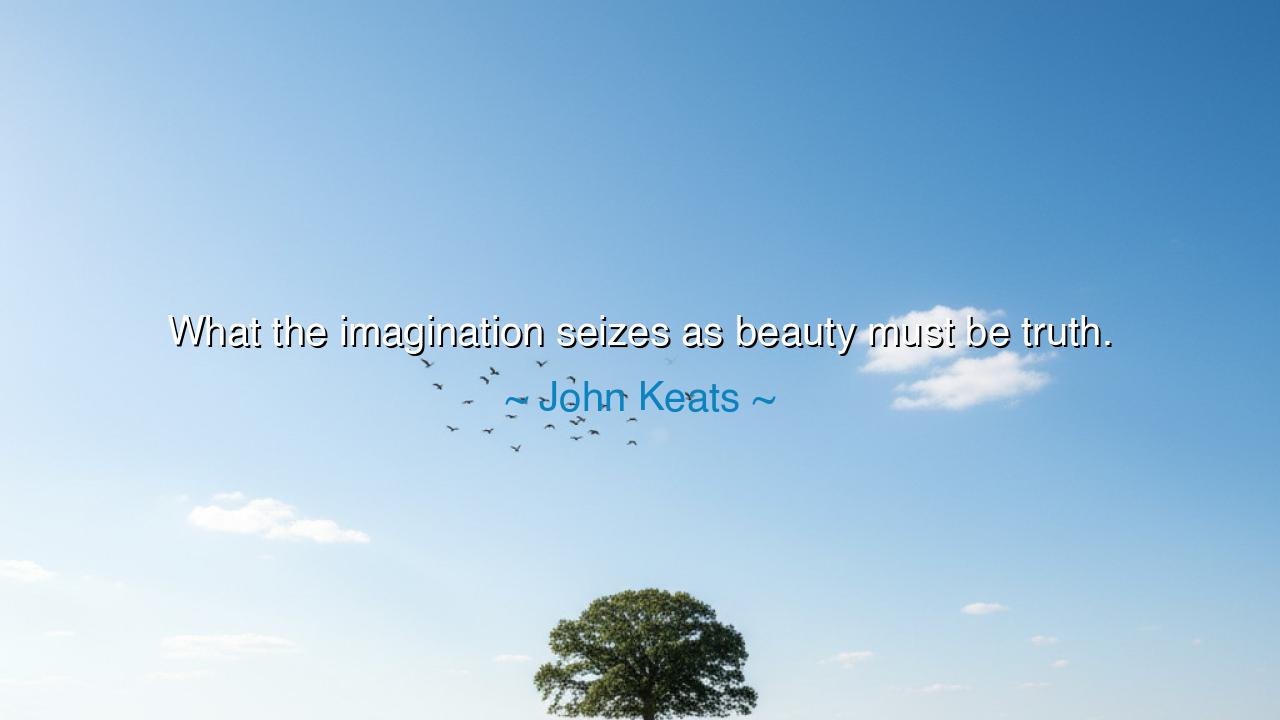
What the imagination seizes as beauty must be truth.






In the immortal words of John Keats, poet of beauty and truth, there is a wisdom as radiant as the dawn: “What the imagination seizes as beauty must be truth.” In this single line, Keats opens to us the heart of all art, all vision, all love. For he teaches that beauty and truth are not separate things, but reflections of one eternal light — and that the imagination, that divine power within the human spirit, is the bridge between them. To perceive true beauty, he tells us, is not to be deceived by illusion; it is to glimpse the very fabric of truth itself, shining through the veil of the world.
The imagination, in Keats’s vision, is not a mere dream-maker or conjurer of fancies. It is a sacred faculty, a kind of inner eye through which the soul perceives what intellect alone cannot grasp. To the philosopher, truth is logic; to the scientist, it is proof; but to the poet — and to the awakened heart — truth reveals itself through beauty. When the imagination is pure, unclouded by greed or fear, it recognizes beauty instinctively — not as ornament, but as essence. Thus, when the poet or artist encounters something that stirs the soul with awe or tenderness, that moment of recognition is not false. It is the soul whispering, “This is real.”
The origin of these words can be traced to the romantic soul of Keats himself, who lived and wrote in an age when reason sought to dominate imagination. Against the cold rationalism of his time, Keats stood as a champion of feeling, intuition, and the transcendent power of beauty. In his poems — like “Ode on a Grecian Urn” or “Ode to a Nightingale” — he sought to express truths that could not be measured or dissected, but only felt. For Keats, imagination was the soul’s instrument of knowing — a divine faculty through which we experience reality’s deepest harmony. When beauty moves us to tears, he believed, it is because our spirit recognizes in that beauty something eternal, something true.
Consider, for example, the life of Vincent van Gogh, whose vision of the world was shaped not by reason, but by a fierce and holy imagination. To others, a night sky was a darkness filled with stars; to him, it was a living fire, a swirling ocean of divine energy. He painted what his soul saw — beauty that was also truth. Though the world mocked him in his lifetime, calling his visions madness, the generations that followed came to see that he was not deluded. His imagination had simply pierced through the surface of appearances to glimpse the deeper music of creation. What he seized as beauty — the trembling light of stars, the sacred dignity of a flower — was indeed truth.
Keats’s teaching reminds us that the imagination is not falsehood, but revelation. It is the instrument by which we perceive the divine in the ordinary, the eternal in the fleeting. A sunset, a melody, a kind word — these may seem fragile things, yet to the imaginative soul, they contain the whole truth of existence. For what is beauty but harmony, and what is truth but the recognition of that harmony? The two are one, like flame and light — different only in name. When the heart is open, the beauty that imagination seizes is not fantasy; it is the deepest reality the world offers to human eyes.
Yet there is a challenge hidden in this wisdom. To perceive beauty as truth, one must purify the imagination. The world is full of false lights — glamor, vanity, and illusion — which masquerade as beauty but lead the spirit astray. The true imagination, Keats would say, does not seek pleasure for its own sake, but seeks meaning. It listens for the quiet music beneath appearances. It finds beauty in simplicity, in kindness, in the courage of the human heart. To cultivate such imagination is to become a seer — one who perceives not only what is, but what is eternal.
So, my child, take this teaching into your soul: trust your imagination, for it is the divine compass of your being. When something fills you with wonder, pause and honor it, for that moment is sacred — it is truth revealing itself in the language of beauty. When you see injustice or cruelty, and it strikes you as ugly, believe that too — for your imagination is recognizing falsehood. Learn to see with the eyes of the heart. Read poetry, walk in nature, listen to music that stirs your spirit — these are not idle pleasures, but exercises of truth.
And remember this final lesson: as John Keats wrote near the end of his life, “Beauty is truth, truth beauty.” He died young, but his words endure because they are themselves the embodiment of that union. To live imaginatively is to live truthfully, and to live truthfully is to live beautifully. Therefore, cherish your imagination as the ancients cherished their oracles — for it is your bridge to eternity, and through it, every act of seeing becomes an act of knowing, and every encounter with beauty becomes a glimpse of truth.






AAdministratorAdministrator
Welcome, honored guests. Please leave a comment, we will respond soon